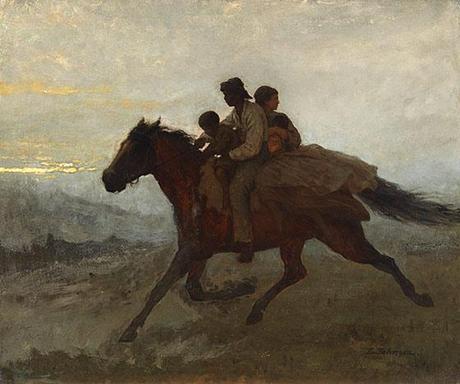This blog post is part of a monthly Eye Level feature on our exhibition The Civil War and American Art. Curator Eleanor Harvey talks about many of the important intersections between American art and the Civil War. The exhibition runs through April 28, 2013.

Eastman Johnson, A Ride for Liberty—The Fugitive Slaves, March 2, 1862, 1862, oil on board, Virginia Museum of Fine Arts, Richmond. The Paul Mellon Collection, Photo: Katherine Wetzel, © Virginia Museum of Fine Arts
When the Civil War broke out, enslaved people took great risks and endured hardships to achieve freedom. In May 1861, barely a month after the first battle, Union General Benjamin Butler took in three black men who had escaped from their master, a Confederate colonel stationed near Fortress Monroe, Virginia. In defiance of the Fugitive Slave Act, which required all escaped slaves to be returned to their masters, Butler announced that all enslaved people who arrived safely across Union lines were to be considered "contraband of war." He and other commanders quickly found themselves overwhelmed by the number of escapees in their camps, many of whom would work willingly building forts, digging trenches, and providing intelligence on the position of Confederate forces in exchange for sustenance, protection, and the hope of a Union victory. What started as a trickle of fugitives grew to a steady flow as word spread and Union forces advanced. With these acts of personal resistance, black people contributed to their own emancipation and to the eventual uprooting of slavery in the United States.
In early March 1862 artist Eastman Johnson accompanied Union General George McClellan from Washington, D.C., to Manassas, Virginia. Based on this experience, Johnson painted A Ride for Liberty—The Fugitive Slaves, March 2, 1862, presenting a tense moment as a black family makes a break for the Union lines. Johnson set his narrative in the chilly predawn glow, the eerie bluish tints tinged with pink as the sun begins to rise. The horse trots quickly across the rolling terrain, the father leaning forward over the horse's withers, urging him on. The man is focused on the future and on the struggle to achieve freedom for his family. Sitting in front, his young son echoes the father's resolve. The wife sits behind her husband, one arm around his waist to hold herself in place against the bone-jarring gait of the horse, the other clasping an infant to her chest. She looks back, half in fear and watchfulness, half in sorrow for what she might have left behind. For as they move forward to a new life, they cast off the familiar—friends, possibly family, even routines—in short, the only lives they have known.
What would become of this brave family? Johnson's inscription on the back of the painting offers a clue. It reads, "A veritable incident in the civil war seen by myself at Centerville on the morning of McClellan's advance towards Manassas. March 2nd 1862." Unlike Butler, McClellan was one of many Union commanders who returned fugitives to their owners. But Johnson leaves the question of their reception open ended. A Ride for Liberty has everything to do with capturing the gripping saga of a black family escaping from enslavement, but it contains the added dimension of uncertainty. Better than any other painting, it captures the moment when the full scope of the slavery question begins to loom. Johnson placed these people squarely in the foreground and, in doing so, elevated their plight in the national debate.

